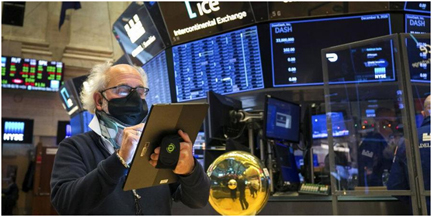While lockdown life has kept time standing still for nearly everyone through 2020, Wall Street has been locked in at super fast-forward. The stock market tumbled through years’ worth of losses in just over a month this spring, only to turn around and pack an entire bull market’s worth of gains into less than nine months.
Even within the span of a few hours, the market in 2020 would sometimes careen to a loss that would have been remarkable for a full year. Consider one day in March, when the S&P 500 plunged 12% after President Donald Trump acknowledged a recession may be on the way because of the pandemic.
That was a worse loss than the index has suffered in 45 of the last 50 full years.
The good news is that the crazy action for markets in 2020 was likely a singular response to COVID-19, not a preview of a new normal.
Market watchers say investors can expect movements closer to what they’re used to next year, as the economy is nursed back to health following the rollout of one or more COVID-19 vaccines.
If anything, analysts say the whiplash provides another lesson that holding steady is often the best response for investors to crashing prices, rather than trying to time the market.
The fast-forward movements of this year just mean sticking to that strategy paid off much more quickly this time around. “It’s almost universally the case that you do not want to sell into a panic,” said Yung-Yu Ma, chief investment strategist at BMO Wealth Management.
“That is something that investors still have a hard time realizing in a moment where it seems like there’s every reason to sell. But that principle is definitely a lesson to be taken away.”
Of course, the temptation to sell was tough to ignore when so much confusion was crashing through the market this year and prices were zooming at what seemed 10 or 100 times normal speed.
Consider: – Between Feb. 19 and March 23, the S&P 500 plunged nearly 34% as panic over the economic damage the pandemic could cause swept through markets .
That’s close to the average drop of 39.4% for the 14 bear markets that have struck since 1929.
But the average bear market lasted nearly 20 months. This one ran its course in a little more than 20 trading days and was the fastest on record, according to S&P Dow Jones Indices.
– Almost as quickly as it plunged, the stock market zoomed higher again.
It regained all its losses in less than five months, and the surge was so lightning-quick that many professional investors at first doubted it could last.
The S&P 500 has climbed 63.9% in eight-plus months, as of Thursday.
That rivals the 64.8% it rose in the entire bull market that lasted 31 months following the 1987 Black Monday crash.
– Through all the tumult, the S&P 500 had 10 days this year where it swung up or down by more than 5%.
Over the last decade, outside of 2020, that happened just once.
Since the Great Depression, only 2008 had as many big daily moves, and back then investors were bracing for the collapse of the entire financial system.
In retrospect, analysts say all the market’s moves make sense.
Early in the sell-off, investors were flying blind regarding how infectious and deadly this new coronavirus was and how long widespread lockdowns would last.
Wall Street’s instinctive reaction to any kind of uncertainty is to flee, and stocks sold off.
But the Federal Reserve and Congress both stepped in forcefully during March, promising unprecedented amounts of aid for markets and the economy.
Interest rates went back to nearly zero, dollars flooded into far-ranging corners of the bond market and Washington sent out cash payments to most Americans to help fill the economic cavern created by the corona virus.
“They learned a lot of lessons during the financial crisis, and they applied them,” said Margie Patel, senior portfolio manager at Wells Fargo Asset Management.
That quick action – and commitment to keeping markets afloat – is one of the biggest takeaways of the year for her.
“You had the government explicitly telling you we have a floor for the markets below which values will not go.”
With the Federal Reserve promising to keep interest rates low even if inflation rises back above its 2% target, many professional investors say they expect the market to be much calmer in 2021.
And beyond the efforts of the Fed, encouraging data on potential COVID-19 vaccines means much of Wall Street expects life to begin returning to normal in 2021, which should broaden the economic recovery, restore corporate profits and also help smooth out Wall Street’s ride.
“There seem to be a lot of things to worry about,” Patel acknowledges.
“But when you look at the big picture, it’s surprising how good things are.”
Source: AP
